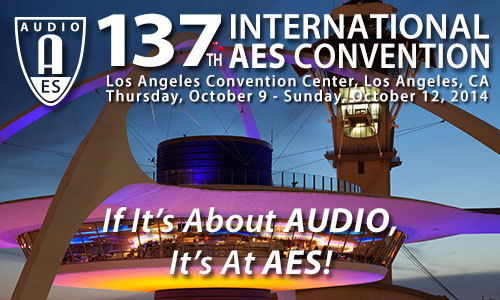AES Los Angeles 2014
Paper Session P9
P9 - Transducers—Part 2
Friday, October 10, 2:00 pm — 4:30 pm (Room 309)
Chair:
Mario Di Cola, Audio Labs Systems - Casoli (CH), Italy
P9-1 The Implementation of MEMS Microphones for Urban Sound Sensing—Charlie Mydlarz, New York University, CUSP - New York, NY, USA; Samuel Nacach, New York University - New York, NY, USA; Agnieszka Roginska, New York University - New York, NY, USA; Tae Hong Park, New York University - New York, NY, USA; Eric Rosenthal, New York University - New York, NY, USA; Michelle Temple, New York University - New York, NY, USA
The urban sound environment of New York City (NYC) is notoriously loud and dynamic. The current project aims to deploy a large number of remote sensing devices (RSDs) throughout the city, to accurately monitor and ultimately understand this environment. To achieve this goal, a process of long-term and continual acoustic measurement is required, due to the complex and transient nature of the urban soundscape. Urban sound recording requires the use of robust and resilient microphone technologies, where unpredictable external conditions can have a negative impact on acoustic data quality. For the presented study a large-scale deployment is necessary to accurately capture the geospatial and temporal characteristics of urban sound. As such, an implementation of this nature requires a high-quality, low-power, and low-cost solution that can scale viably. This paper details the microphone selection process involving the comparison between a range of consumer and custom made MEMS microphone solutions in terms of their environmental durability, frequency response, dynamic range, and directivity. Ultimately a MEMS solution is proposed based on its superior resilience to varying environmental conditions and preferred acoustic characteristics.
Convention Paper 9143 (Purchase now)
P9-2 Graphene Oxide Based Materials as Acoustic Transducers: A Ribbon Microphone Application Case Study—Peter Gaskell, McGill University - Montreal, Quebec, Canada; GKL Audio Inc. - Montreal, Quebec, Canada; Robert-Eric Gaskell, McGill University - Montreal, QC, Canada; GKL Audio Inc. - Montreal, QC, Canada; Jung Wook (Jonathan) Hong, McGill University - Montreal, QC, Canada; GKL Audio Inc. - Montreal, QC, Canada; Thomas Szkopek, McGill University - Montreal, Quebec, Canada
Materials used in acoustic transducer membranes need very specific qualities that in any real system require many tradeoffs to be made. Graphene and graphene related materials are a newly discovered class of materials with some exceptional properties that has the potential to make significant contributions to the performance of many acoustical transduction systems. The properties of graphene relevant to transducer applications are discussed and two graphene based films, an aluminum coated Graphene Oxide film and an aluminum coated reduced Graphene Oxide film, are tested in a ribbon microphone application. Physical and acoustical measurements of the films indicate that with minor improvements, ribbon transducers could significantly benefit from graphene-based materials.
Convention Paper 9144 (Purchase now)
P9-3 Subwoofers in Rooms: Stereophonic Reproduction—Juha Backman, Microsoft - Espoo, Finland
A study based on computational model of interaural level and time differences at the lowest audio frequencies, often reproduced through subwoofers, is presented. This work studies whether interaural differences can exist, and if they do, what kind of relationship there is between the loudspeaker direction and the interaural differences when monophonic and stereophonic subwoofer arrangements are considered. The calculations are made for both simple amplitude panned signals and for simulated microphone signals. The results indicate that strong narrow-band differences can exist, especially near room eigenfrequencies when the listener is close to nodes of the room modes and that the modes of the recording room can have an effect on the sound field of the listening room.
Convention Paper 9145 (Purchase now)
P9-4 Subwoofer Design with Moving Magnet Linear Motor—Mario Di Cola, Audio Labs Systems - Casoli (CH), Italy; Claudio Lastrucci, Powersoft S.p.a. - Scandicci (FI), Italy; Lorenzo Lombardi, Powersoft S.p.a. - Scandicci, FL, Italy
A new electro-dynamic transducer has been studied, based on a moving magnet linear motor instead of a traditional moving coil, and it has been carefully described into a recently presented paper from Claudio Lastrucci. This moving magnet motor could considerably improve the conversion efficiency and the sound quality at the lowest frequency range. It has been developed around a fully balanced and symmetrical moving magnet motor geometry and it can significantly reduce the distortion, in the lowest range, to a fraction if compared to that of a conventional moving coil loudspeaker in the same range. It also offers a considerably higher power handling and overall robustness thus being able of reproducing the lowest range on bass spectrum with an unprecedented level of quality and output. The novel motor design also shows a considerable high acceleration that makes it suitable for the application also in the upper bass region. This paper proposes a review of the methodology that can be pursued in subwoofer design while using this motor technology. The new motor technology will require a different approach to subwoofer design. Several aspects that are in common with conventional loudspeakers will be outlined while also described those characteristics that differs significantly. The application of the technology and relative results will be shown through examples of practical applications and with measurement results.
Convention Paper 9146 (Purchase now)
P9-5 A Direct Driver for Electrostatic Transducers—Dennis Nielsen, Technical University of Denmark - Kgs. Lyngby, Denmark; Arnold Knott, Technical University of Denmark - Kgs. Lyngby, Denmark; Michael A. E. Andersen, Technical University of Denmark - Kgs. Lyngby, Denmark
Electrostatic transducers represent a very interesting alternative to the traditional inefficient electrodynamic transducers. In order to establish the full potential of these transducers, power amplifiers that fulfill the strict requirements imposed by such loads (high impedance, frequency depended, nonlinear, and high bias voltage for linearization) must be developed. This paper analyzes a power stage suitable for driving an electrostatic transducer under biasing. Measurement results of a plus/minus 400 V prototype amplifier are shown. THD below 1 % is reported.
Convention Paper 9147 (Purchase now)
